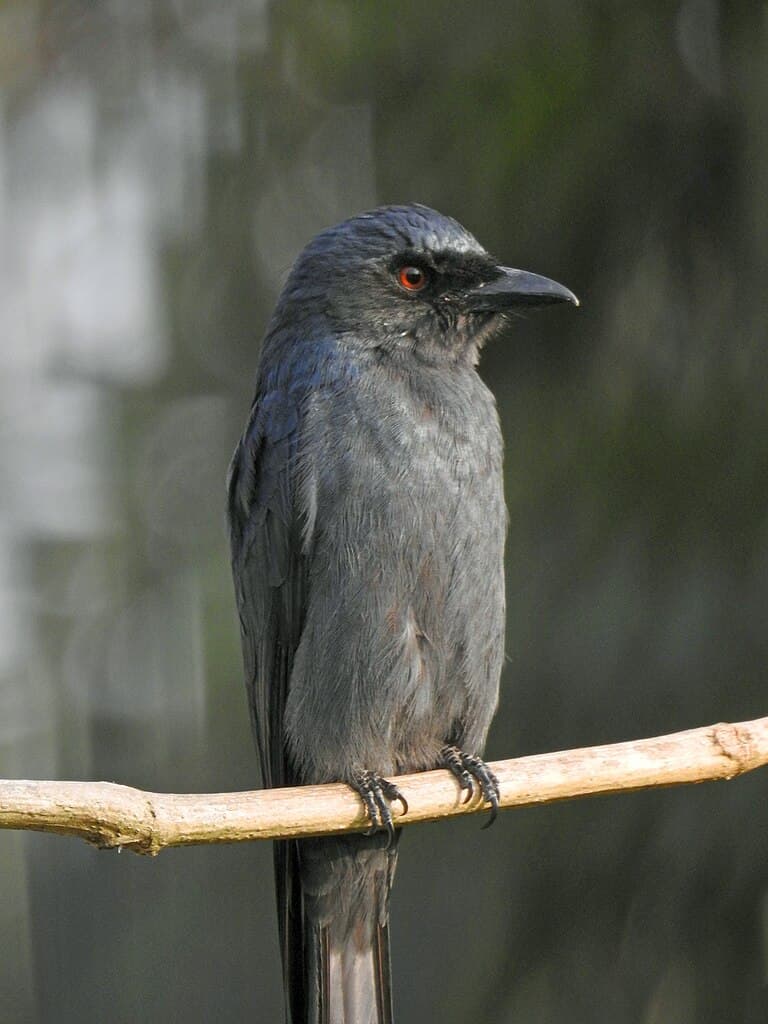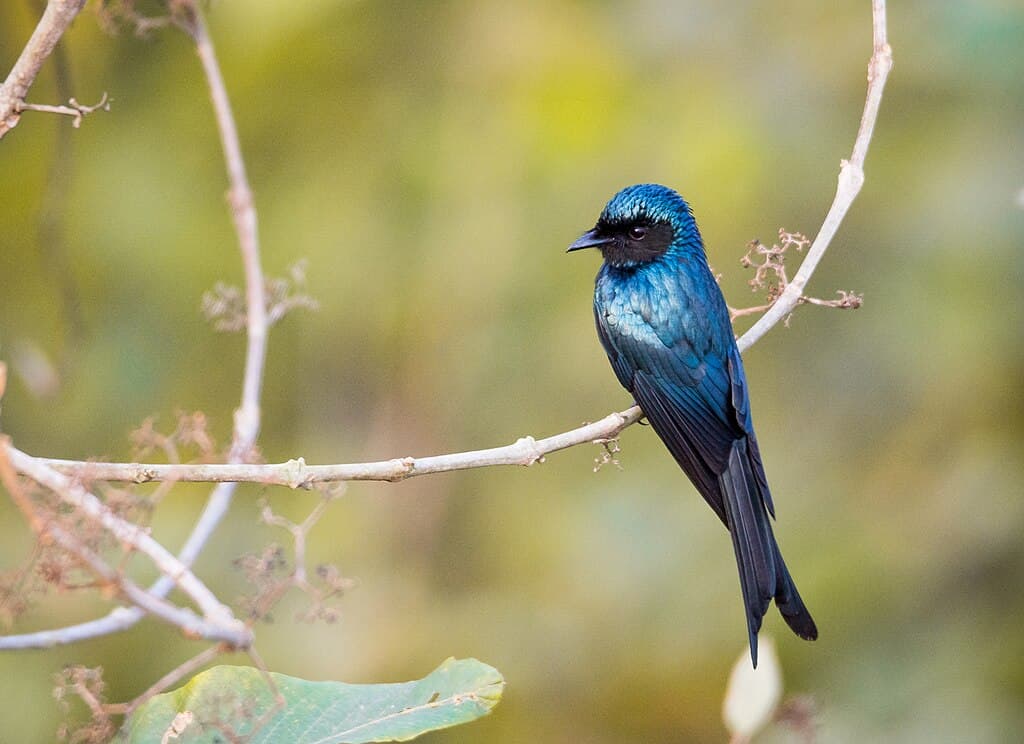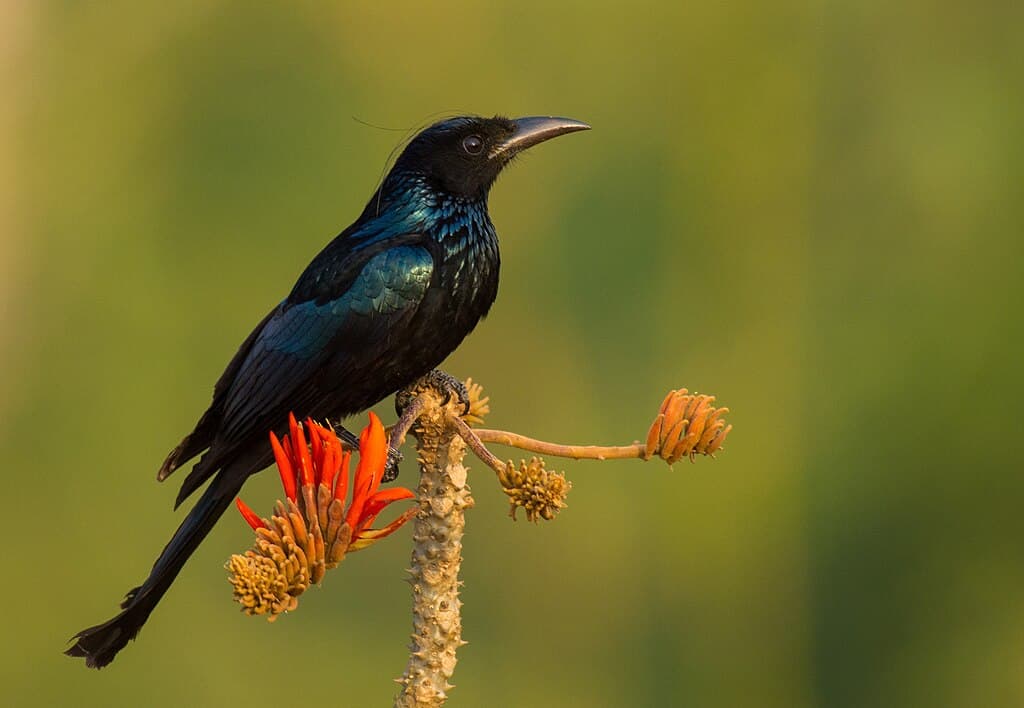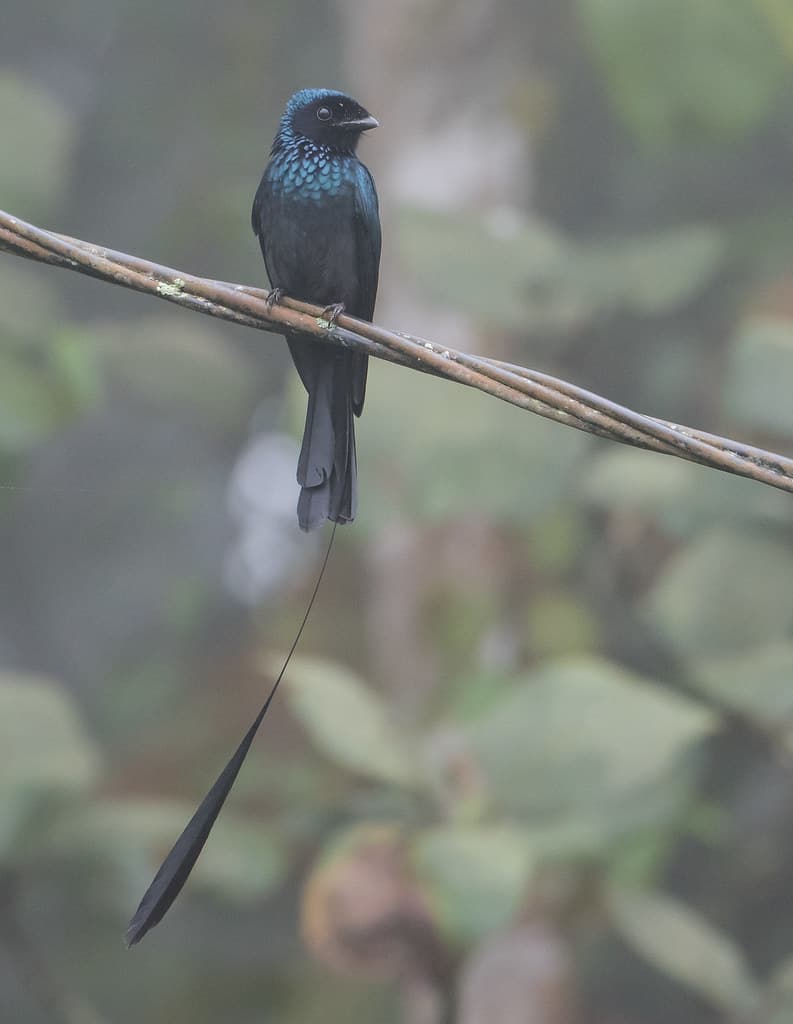Among 31 species in the world, there are 7 drongo species in Cambodia that we know of. Drongos (អន្ទេប) are black or dark gray birds with metallic tints, and they have short legs and very interesting-looking tails. The longer I look at them, the more beautiful they look. Every detail about each species is just very eye-catching, and I hope you will like them too. Feel free to check out the information about all 9 drongo species in Cambodia below, which one is the most gorgeous?
Ashy Drongo (អន្ទេបប្រផេះ)

An ashy drongo grows from 25.5 to 29 centimeters big, and different ranges also mean different colorations as well. A common ashy drongo has dark gray underparts and slate-gray upperparts with blue-gray gloss. One of the most interesting features about this bird is the long deeply forked tail that you can easily notice. They inhabit forests, forest edges, and open forests, especially hill forests and mountain areas across Asia. This bird has very short legs, and it usually sits very upright while perching high on a tree. As insectivores, ashy drongos feed on a number of insects and their favorite meals are flying insects. Apart from insects, they also consume nectar and vertebrates that they can find as well.
Black Drongo (អន្ទេបខ្មៅ)

As for black drongos, they are all-black birds that have a distinctive wide forked tail just like other drongo species. In fact, the long forked tail is the main thing that differentiates the black drongos from crows. The bird measures around 28 centimeters long but it is capable of fast maneuvers when it comes to hunting. While being medium-sized birds, black drongos are quite aggressive towards larger birds like crows; hence the nickname “king crow”. They are not afraid to display aggressive behavior like bomb-diving any birds that invade their territory. Black drongos have a wide distribution across Asia, inhabiting light forests and open agricultural areas.
Black drongos are very active early at dawn, and they usually hunt close to the ground and tree branches. They have short legs, and they spend most of their time sitting upright on thorny bushes instead of perching on trees. Some of their favorite meals are insects including ants, bees, beetles, cicadas, crickets, dragonflies, grasshoppers, locusts, moths, termites, and wasps. However, there are also many brave black drongos out there that prey on fish, small birds, and reptiles. They hunt other birds by striking at the back of the prey’s head and neck before feeding on certain parts like the brain. Some even take on larger arthropods like centipedes and scorpions, quite a fierce drongo species, indeed.
Bronzed Drongo (អន្ទេបខ្មៅរលោង)

Looking absolutely stunning, a bronzed drongo has metallic gloss with a spangled appearance on its breast, head, and neck. That gorgeous metallic bronze plumage even shines under sunlight which makes it even more beautiful. At the same time, it has velvet lores and ear coverts with a slender forked tail. The unique part about the tail is the fact that the outer tail feathers slightly flair outward. This drongo species live exclusively in forested areas across the Indian Subcontinent and Southeast Asia. Their common habitats are broad-leaved woodland, forest edges, and sub-montane rainforests.
Across their range, they fly either singly or in a group of just two or three birds only. Not different from most drongos, this one also feeds on insects and nectar that they can find. Their favorite meals are beetles, grasshoppers, moths, spiders, and more. Despite being only 24 centimeters in size, these drongos are not afraid to attack larger birds if their nest or young are threatened. They have acrobatic flying skills that allow them to fly swiftly as they pursue flying insects in midair. On top of that, they also have incredible mimicry skills as they can produce various calls of other drongos and birds.
Crow-Billed Drongo (អន្ទេបចំពុះក្អែក)

Similar to the black drongos, the crow-billed drongos are also completely black in color with a shallow forked tail. One of the features that allows you to tell these two birds apart is the stout bill that crow-billed drongos possess. The base of a crow-billed drongo’s bill is broader and thicker than a black drongo’s bill. Since the bill of this drongo species looks very similar to that of a crow, it earns its name. It grows to around 27 to 32 centimeters including the forked tail with outer tail feathers that curve outwards.
Crow-billed drongos are native to moist tropical forests of Southeast Asia, especially in subtropical or tropical moist lowland forests and subtropical or tropical mangrove forests. Along with that, they also inhabit dense evergreen forests and moist deciduous forests where they build their nests and breed. Throughout their range, this drongo species mostly feed on insects and other small animals.
Greater Racquet-Tailed Drongo (អន្ទេបទងកន្ត្រៃ)

If there is a contest for the most beautiful drongo species, this one definitely wins. Would you look at that? A greater racquet-tailed drongo has a glossy blue-black body with a metallic sheen and a tail that is around 30 centimeters long. The two most majestic parts of the greater racquet-tailed drongo are the crests and tail feathers. Growing up to 33 to 35.5 centimeters, they are probably the largest drongo species in Asia. You can easily recognize one by its crest of curled feathers above its beak and its twirled tail rackets.
Their range is from India all the way to Southeast Asia, and they inhabit hills and lowland rainforests. Where they live, these drongos feed mainly on insects but they also consume fruits and nectar on the side. Being quite large with a temper, it is normal for them to be aggressive with the tendency to mod larger birds. Not to mention their ability to mimic other raptors and random sounds, this bird is one of a kind.
Hair-Crested Drongo (អន្ទេបកំប៉ោយខ្សែ)

Hair-crested drongos are beautiful birds that grow to a size of 28 to 32 centimeters. Its body is black with metallic blue-green gloss and iridescent blue spangles on its crown, nape, neck, and upper breast. This glossy blue-green sheen and iridescent spangles are the features that distinguish them from other drongo species. It has a few fine hair-like feathers that spring from its forehead that extend over its hind crown; hence the name. The unforked tail of the bird curls upward, and it has short black feet.
This drongo species is native to Bangladesh, Bhutan, and India but also has distribution across China and Indochina as well. They inhabit deciduous forests, evergreen forests, lowlands, mixed woodland, and open country as well as dense jungles. These birds predominantly feed on nectar with its long curvy and pointy bill but they also feed on insects. While many drongo species fly singly or in pairs, this one move in small flocks and they are very noisy. The group can be up to 20 birds, and they mob a predator or bully other nectar-feeding birds off the food sources.
Lesser Racquet-Tailed Drongo (អន្ទេបរំយោលភ្នំ)

Looking similar to the greater racquet-tailed drongos but less stunning, lesser racquet-tailed drongos share many alike features. It grows to around 25 to 27.5 centimeters excluding its 30-40 centimeters long tail. The bird has black feathers with a bluish metallic gloss. You can easily tell this one apart from the greater racquet-tailed drongo by the lack of crest and its square-cut tail. These birds are found in the Indian Subcontinent and Southeast Asia, living near the edge or inside of subtropical or tropical moist montane forests.
Related Post: Nightjar Species In Cambodia
